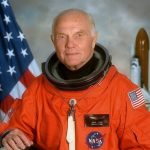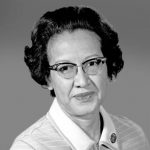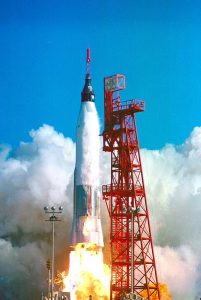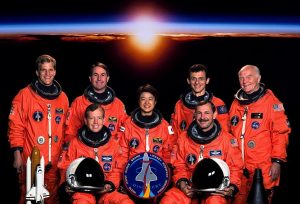john glenn

 Most of us who were around in the 1960s, know about the early space program, and especially the very first American to orbit the Earth…John Glenn. John Glenn’s historic flight put the United States on the map of the space race, so to speak. It all seems very commonplace in this day and age of space shuttles, and the International Space Station, but the reality was that this first American orbit could have ended tragically.
Most of us who were around in the 1960s, know about the early space program, and especially the very first American to orbit the Earth…John Glenn. John Glenn’s historic flight put the United States on the map of the space race, so to speak. It all seems very commonplace in this day and age of space shuttles, and the International Space Station, but the reality was that this first American orbit could have ended tragically.
While some change had happened concerning blacks and women, there was still much that had not changed. Women were not viewed as mathematically inclined, and black women even less so. That was before they knew about Katherine Johnson. Katherine Johnson was handpicked to be one of three black students to integrate West Virginia’s graduate schools. Born in White Sulphur Springs, West Virginia in 1918, her intense curiosity and brilliance with numbers vaulted her ahead several grades in school. She graduated from high school at the age of 14, and the historically black West Virginia State University at 18, where she had made quick work of the school’s math curriculum. Katherine graduated with highest honors in 1937 and took a job teaching at a black public school in Virginia, but this was not to be her career.
In 1935, the NACA (National Advisory Committee for Aeronautics, a precursor to NASA) hired five women to be their first computer pool at the Langley campus. “The women were meticulous and accurate…and they didn’t have to pay them very much,” NASA’s historian Bill Barry says, explaining the NACA’s decision. Six months later, after the attack on Pearl Harbor brought the United States into World War II, NACA and Langley began recruiting African-American women with college degrees to work as human computers.
Johnson was hired by NACA in 1953. Johnson, along with Dorothy Vaughan, and Mary Jackson, became part of NASA’s team of human computers. These people were mathematicians who performed the necessary calculations to make space flight possible in a time when “machine computers” didn’t exist, or were very new. Johnson was perfect for this job. After working for Nasa a while, and really proving her worth, Johnson was still running into road blocks. When NASA engineer Paul Stafford was preparing a meeting about John Glenn’s upcoming mission. Johnson felt that she needed to be at that meeting to explain her numbers, but Stafford refused her the request to attend stating, “There’s no protocol for women attending.” Johnson instantly replied, “There’s no protocol for a man circling Earth either, sir.”
Johnson saw an opportunity when NASA installed huge IBM computers…that no one knew how to use. They tried to get the machines set up so that the human computers could be replaced by the far more accurate machines, but the set up proved too difficult, until Johnson taught herself to use the machines. She then taught the rest of the black women, human computers to run them too. In the end, they were the only ones who knew how to do it. It made them much more important to the space program. The men had to face the fact that the women, that they had all but discounted, were going to be the ones to save the space program.
The biggest highlight of Katherine Johnson’s career came at the point when John Glenn was getting ready to  make that historic first orbit around the Earth. Johnson’s main job in the lead-up and during the mission was to double-check and reverse engineer the newly-installed IBM 7090s trajectory calculations. There were very tense moments during the flight that forced the mission to end earlier than expected. John Glenn requested that Johnson specifically check and confirm trajectories and entry points that the IBM put out. Glenn didn’t completely trust the computer. So, he asked the head engineers to “get the girl to check the numbers…If she says the numbers are good…I’m ready to go.” Johnson couldn’t have been given a greater seal of approval than to have John Glenn say that she was the only one he trusted…after all, it was his life.
make that historic first orbit around the Earth. Johnson’s main job in the lead-up and during the mission was to double-check and reverse engineer the newly-installed IBM 7090s trajectory calculations. There were very tense moments during the flight that forced the mission to end earlier than expected. John Glenn requested that Johnson specifically check and confirm trajectories and entry points that the IBM put out. Glenn didn’t completely trust the computer. So, he asked the head engineers to “get the girl to check the numbers…If she says the numbers are good…I’m ready to go.” Johnson couldn’t have been given a greater seal of approval than to have John Glenn say that she was the only one he trusted…after all, it was his life.

 I’m sure that many of you remember the movie, Deep Impact, which was about a group of astronauts trying to save the world by deflecting a meteor, so it wouldn’t hit the earth. Robert Duvall played the part of Captain Spurgeon “Fish” Tanner, a retired, and largely considered by the rest of the crew, an “over the hill” astronaut. Nevertheless, in the end, they were glad they had him when it came to completing their mission, even though it did cost them their lives. Of course, the movie was fictional, and not realistic in many aspects, but the part that struck me as cool, was that the retired astronaut got a second chance to be useful in an important mission.
I’m sure that many of you remember the movie, Deep Impact, which was about a group of astronauts trying to save the world by deflecting a meteor, so it wouldn’t hit the earth. Robert Duvall played the part of Captain Spurgeon “Fish” Tanner, a retired, and largely considered by the rest of the crew, an “over the hill” astronaut. Nevertheless, in the end, they were glad they had him when it came to completing their mission, even though it did cost them their lives. Of course, the movie was fictional, and not realistic in many aspects, but the part that struck me as cool, was that the retired astronaut got a second chance to be useful in an important mission.
However, Captain Spurgeon Tanner wasn’t the only retired astronaut to get a second chance to go into space. On October 29, 1998, nearly four decades after he became the first American to orbit the Earth, Senator John Hershel Glenn Jr was launched into space again as a payload specialist aboard the space shuttle Discovery. At 77 years of age, Glenn was the oldest human ever to travel in space. During the nine day mission, he served as part of a NASA study on health problems associated with aging. Like our fictional Captain Spurgeon Tanner, Senator John Glenn was useful in space again. He had something that the other astronauts didn’t have…age. I don’t suppose that the studies done on John Glenn were the saving the world type, but they were real life studies, and that’s important too.
John Glenn became famous when he was chosen by NASA in 1959, along with six other men, to be the first American astronauts. He was a lieutenant colonel in the US Marine Corps. A decorated pilot, he flew nearly 150 combat missions during World War II and the Korean War. In 1957, he made the first nonstop supersonic flight across the United States, flying from Los Angeles to New York in three hours and 23 minutes. Then, in April 1961, the American space program suffered a setback of sorts, when Soviet cosmonaut Yuri Gagarin became the first man in space, and his spacecraft, Vostok 1, made a full orbit before returning to Earth. It was a feat that the United States had hoped to achieve first. The United States kicked things into high gear, and less than one month later, American Alan Shepard Jr became the first American in space when his Freedom 7 spacecraft was launched on a suborbital flight. American “Gus” Grissom made another suborbital flight in July. Then, in August, Soviet cosmonaut Gherman Titov spent more than 25 hours in space aboard Vostok 2, making 17 orbits. As a technological power, the United States looked second-rate, compared with its Cold War adversary.
If the Americans wanted to dispel this notion, they needed a multi-orbital flight before another Soviet space advance arrived. On February 20, 1962, NASA and Colonel John Glenn accomplished this feat with the flight of Friendship 7, a spacecraft that made three orbits of the Earth in five hours. Glenn was hailed as a national hero, and on February 23 President John F. Kennedy visited him at Cape Canaveral. Glenn later addressed Congress and was given a ticker-tape parade in New York City. It was at this point that NASA made the unfortunate decision not to risk the life of the now famous Glenn by sending him into space again. NASA essentially grounded the “Clean Marine” in the years after his historic flight. Frustrated with this uncharacteristic lack of activity, Glenn turned to politics, In 1964, he announced his candidacy for the US Senate from his home state of Ohio and formally left NASA. Later that year, however, he withdrew his Senate bid after seriously injuring his inner ear in a fall from a horse. In 1970, following a stint as a Royal Crown Cola executive, he ran for the Senate again but lost the Democratic nomination to Howard Metzenbaum. Four years later, he defeated Metzenbaum, won the general election, and went on to win re-election three times. In 1984, he unsuccessfully sought the Democratic nomination for president.


His really big claim to fame would once again come from NASA, which seemed to be his destiny after all. In 1998, Glenn attracted considerable media attention when he returned to space aboard the space shuttle Discovery. In 1999, he retired from his US Senate seat after four consecutive terms in office, a record for the state of Ohio. While his years in politics were much longer, he will always be remembered for the two historic flights he made into space.

